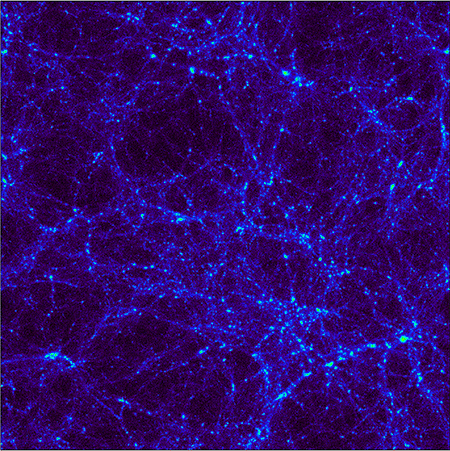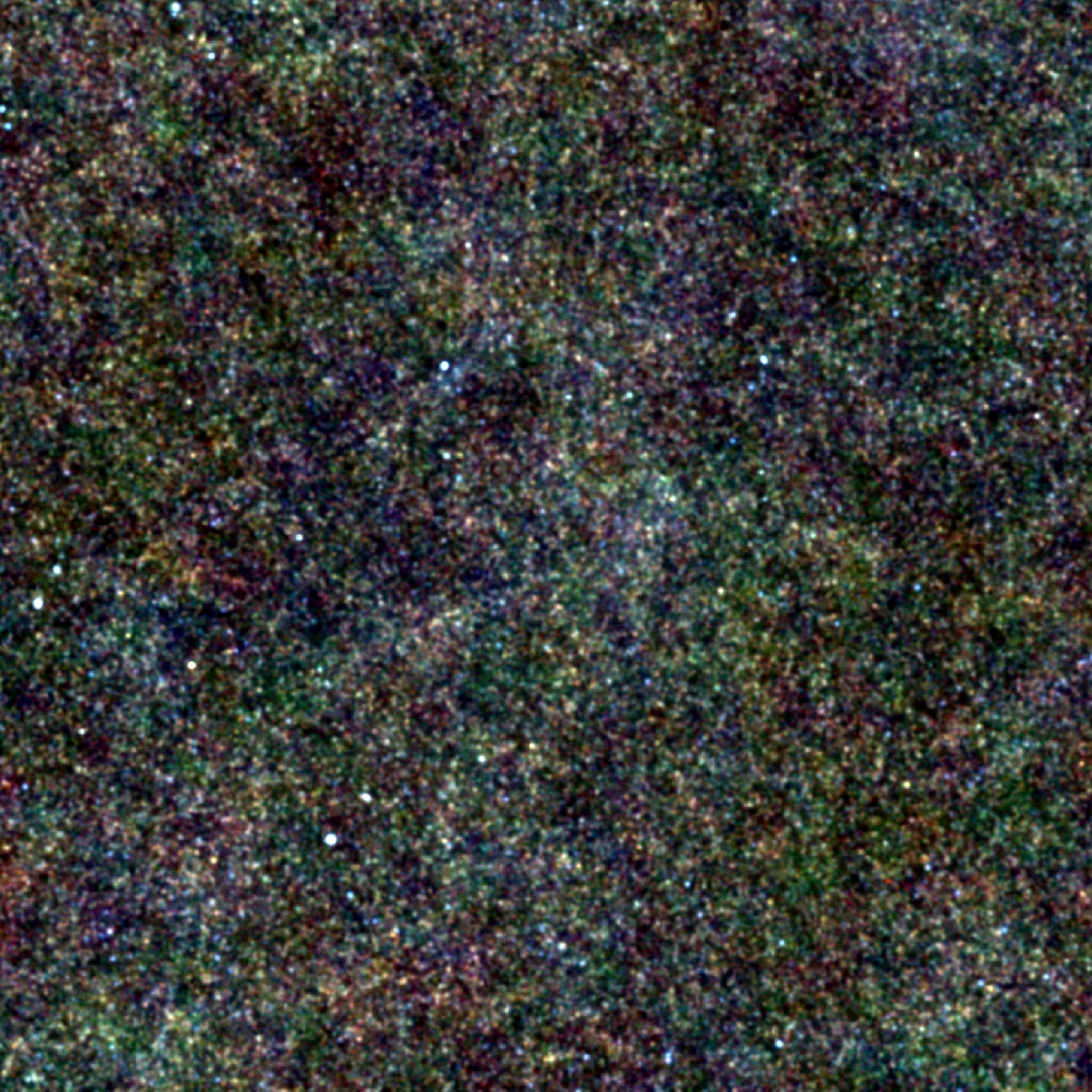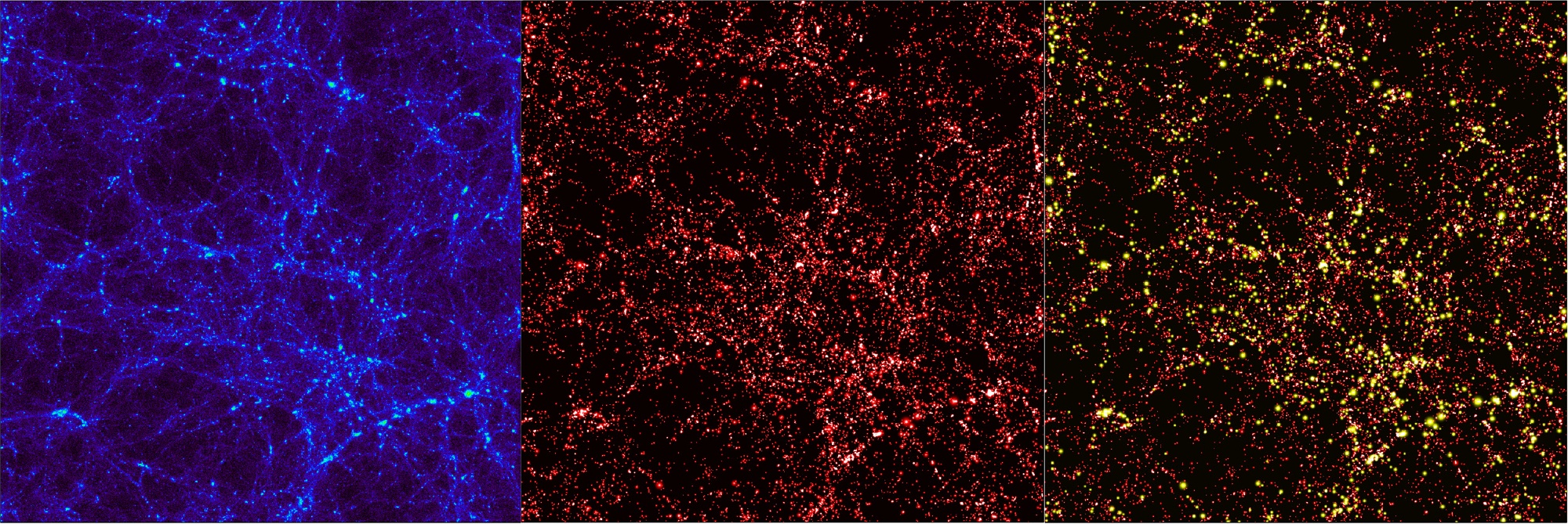ESA's Herschel space observatory has discovered a population of dust-enshrouded galaxies that do not need as much dark matter as previously thought to collect gas and burst into star formation.
The galaxies are far away and each boasts some 300 billion times the mass of the Sun. The size challenges current theory that predicts a galaxy has to be more than ten times larger, 5000 billion solar masses, to be able form large numbers of stars.
The new result is published today in a paper by Alexandre Amblard, University of California, Irvine, and colleagues.
Most of the mass of any galaxy is expected to be dark matter, a hypothetical substance that has yet to be detected but which astronomers believe must exist to provide sufficient gravity to prevent galaxies ripping themselves apart as they rotate.
Current models of the birth of galaxies start with the accumulation of large amounts of dark matter. Its gravitational attraction drags in ordinary atoms. If enough atoms accumulate, a 'starburst' is ignited, in which stars form at rates 100–1000 times faster than in our own galaxy does today.
"Herschel is showing us that we don't need quite so much dark matter as we thought to trigger a starburst," says Asantha Cooray, University of California, Irvine, a co-author on today's paper.
This discovery was made by analysing infrared images taken by Herschel's SPIRE (Spectral and Photometric Imaging Receiver) instrument at wavelengths of 250, 350, and 500 microns. These are roughly 1000 times longer than the wavelengths visible to the human eye and reveal galaxies that are deeply enshrouded in dust.
CLICK FOR LARGER SIZE. This set of images shows the distribution of the dark matter, obtained from a numerical simulation, at a redshift z~2, or when the Universe was about 3 billion years old. The left panel displays the continuous distribution of dark matter particles, showing the typical wispy structure of the cosmic web, with a network of sheets and filaments that developed out of tiny fluctuations in the early Universe. The central panel provides a simplified view of the complex network of dark matter structure according to the so-called halo model, a statistical approach used to describe the distribution of dark matter on both large and small scales. Within this framework, the dark matter distribution is viewed as an ensemble of discrete objects, the dark matter halos, corresponding to the densest knots of the cosmic web. The right panel highlights the dark matter halos (shown in yellow) that represent the most efficient cosmic sites for the formation of galaxies. Only halos with a mass above a certain threshold can trigger the ignition of intense bursts of star formation, thus creating a starburst galaxy. According to the latest measurements achieved with Herschel, the minimum mass needed by a halo for a starburst galaxy to form within it is 3 x 10^11 times that of the Sun.
(Photo Credit: The Virgo Consortium/Alexandre Amblard/ESA)
"With its very high sensitivity to the far-infrared light emitted by these young, enshrouded starburst galaxies, Herschel allows us to peer deep into the Universe and to understand how galaxies form and evolve," says Göran Pilbratt, the ESA Herschel project scientist.
There are so many galaxies in Herschel's images that they overlap, creating a fog of infrared radiation known as the cosmic infrared background. The galaxies are not distributed randomly but follow the underlying pattern of dark matter in the Universe, and so the fog has a distinctive pattern of light and dark patches.
 animation shows the distribution of the dark matter, obtained from a numerical simulation, at a redshift z~2, or when the Universe was about 3 billion years old. The first frame displays the continuous distribution of dark matter particles, showing the typical wispy structure of the cosmic web, with a network of sheets and filaments that developed out of tiny fluctuations in the early Universe. The second frame provides a simplified view of the complex network of dark matter structure according to the so-called halo model, a statistical approach used to describe the distribution of dark matter on both large and small scales. Within this framework, the dark matter distribution is viewed as an ensemble of discrete objects, the dark matter halos, corresponding to the densest knots of the cosmic web. The last frame highlights the dark matter halos (shown in yellow) that represent the most efficient cosmic sites for the formation of galaxies. Only halos with a mass above a certain threshold can trigger the ignition of intense bursts of star formation, thus creating a starburst galaxy. According to the latest measurements achieved with Herschel, the minimum mass needed by a halo for a starburst galaxy to form within it is 3 x 10^11 times that of the Sun. Credits: The Virgo Consortium/Alexandre Amblard/ESA
animation shows the distribution of the dark matter, obtained from a numerical simulation, at a redshift z~2, or when the Universe was about 3 billion years old. The first frame displays the continuous distribution of dark matter particles, showing the typical wispy structure of the cosmic web, with a network of sheets and filaments that developed out of tiny fluctuations in the early Universe. The second frame provides a simplified view of the complex network of dark matter structure according to the so-called halo model, a statistical approach used to describe the distribution of dark matter on both large and small scales. Within this framework, the dark matter distribution is viewed as an ensemble of discrete objects, the dark matter halos, corresponding to the densest knots of the cosmic web. The last frame highlights the dark matter halos (shown in yellow) that represent the most efficient cosmic sites for the formation of galaxies. Only halos with a mass above a certain threshold can trigger the ignition of intense bursts of star formation, thus creating a starburst galaxy. According to the latest measurements achieved with Herschel, the minimum mass needed by a halo for a starburst galaxy to form within it is 3 x 10^11 times that of the Sun. Credits: The Virgo Consortium/Alexandre Amblard/ESA
Analysis of the brightness of the patches in the SPIRE images has shown that the star-formation rate in the distant infrared galaxies is 3–5 times higher than previously inferred from visible-wavelength observations of similar, very young galaxies by the Hubble Space Telescope and other telescopes.
Further analysis and simulations have shown that this smaller mass for the galaxies is a sweet spot for star formation. Less massive galaxies find it hard to form more than a first generation of stars before fizzling out. At the other end of the scale, more massive galaxies struggle because their gas cools rather slowly, preventing it from collapsing down to the high densities needed to ignite star formation.
 CLICK FOR LARGER SIZE. False-color image shows a patch of the sky known as the ‘Lockman Hole’, as observed by the SPIRE instrument on board Herschel. Located in northern constellation of Ursa Major, The Great Bear, the ‘Lockman Hole’ is a field on the sky almost devoid of foreground contamination and thus ideally suited for observations of galaxies in the distant Universe. Almost every dot in the image is an entire galaxy, each containing billions of stars and appearing as they did 10–12 billion years ago, when the Universe was only a couple of billion years old. The blue, green and red colours represent the three far-infrared wavelengths used for Herschel’s observations: 250, 350 and 500 micron, respectively. The galaxies shown in white have equal intensity in all three wavebands and are the ones forming the most stars. Detecting these galaxies individually is particularly challenging, as they are both extremely faint and numerous, so many of them overlap in Herschel’s images. This creates a fog of infrared radiation known as the Cosmic Infrared Background (CIB), which reflects the clustering pattern of the galaxies responsible for this fog. Studying the CIB and its fluctuations is thus an extremely powerful tool to explore the way galaxies tend to be grouped on both small and large scales. Credits: ESA & SPIRE consortium & HerMES consortium
CLICK FOR LARGER SIZE. False-color image shows a patch of the sky known as the ‘Lockman Hole’, as observed by the SPIRE instrument on board Herschel. Located in northern constellation of Ursa Major, The Great Bear, the ‘Lockman Hole’ is a field on the sky almost devoid of foreground contamination and thus ideally suited for observations of galaxies in the distant Universe. Almost every dot in the image is an entire galaxy, each containing billions of stars and appearing as they did 10–12 billion years ago, when the Universe was only a couple of billion years old. The blue, green and red colours represent the three far-infrared wavelengths used for Herschel’s observations: 250, 350 and 500 micron, respectively. The galaxies shown in white have equal intensity in all three wavebands and are the ones forming the most stars. Detecting these galaxies individually is particularly challenging, as they are both extremely faint and numerous, so many of them overlap in Herschel’s images. This creates a fog of infrared radiation known as the Cosmic Infrared Background (CIB), which reflects the clustering pattern of the galaxies responsible for this fog. Studying the CIB and its fluctuations is thus an extremely powerful tool to explore the way galaxies tend to be grouped on both small and large scales. Credits: ESA & SPIRE consortium & HerMES consortium
But at this newly identified 'just-right' mass of a few hundred billion solar masses, galaxies can make stars at prodigious rates and thus grow rapidly.
"This is the first direct observation of the preferred mass scale for igniting a starburst," says Dr Cooray.
Models of galaxy formation can now be adjusted to reflect these new results, and astronomers can take a step closer to understanding how galaxies – including our own –came into being.
Source: European Space Agency
